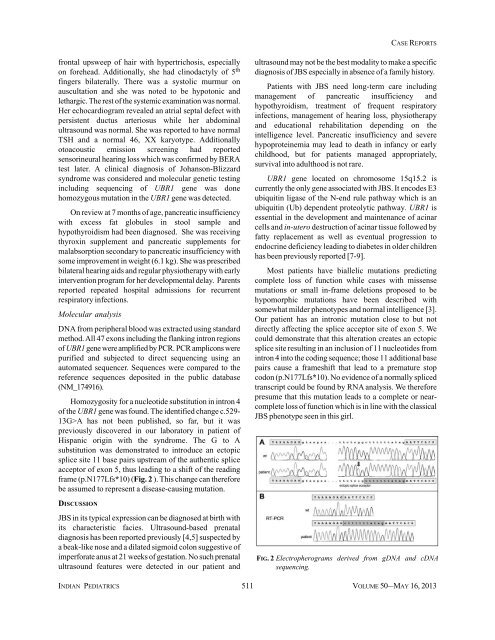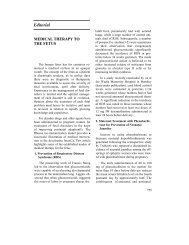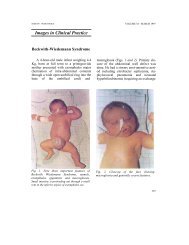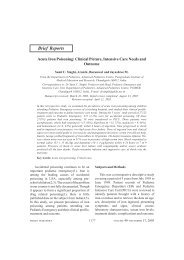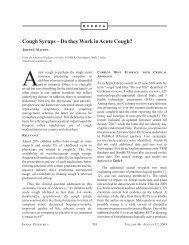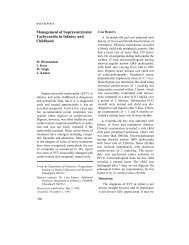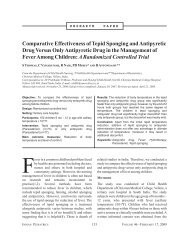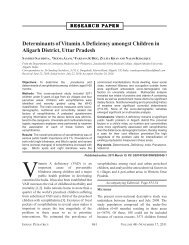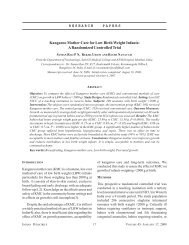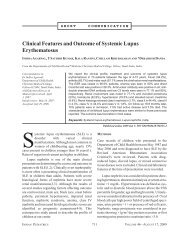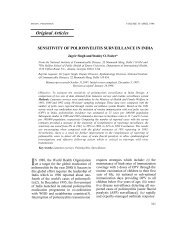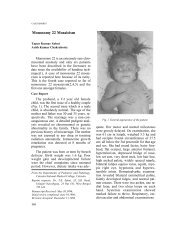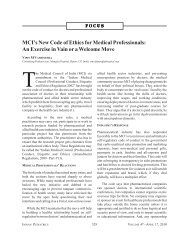Johanson-Blizzard Syndrome - medIND
Johanson-Blizzard Syndrome - medIND
Johanson-Blizzard Syndrome - medIND
You also want an ePaper? Increase the reach of your titles
YUMPU automatically turns print PDFs into web optimized ePapers that Google loves.
CASE REPORTS<br />
frontal upsweep of hair with hypertrichosis, especially<br />
on forehead. Additionally, she had clinodactyly of 5 th<br />
fingers bilaterally. There was a systolic murmur on<br />
auscultation and she was noted to be hypotonic and<br />
lethargic. The rest of the systemic examination was normal.<br />
Her echocardiogram revealed an atrial septal defect with<br />
persistent ductus arteriosus while her abdominal<br />
ultrasound was normal. She was reported to have normal<br />
TSH and a normal 46, XX karyotype. Additionally<br />
otoacoustic emission screening had reported<br />
sensorineural hearing loss which was confirmed by BERA<br />
test later. A clinical diagnosis of <strong>Johanson</strong>-<strong>Blizzard</strong><br />
syndrome was considered and molecular genetic testing<br />
including sequencing of UBR1 gene was done<br />
homozygous mutation in the UBR1 gene was detected.<br />
On review at 7 months of age, pancreatic insufficiency<br />
with excess fat globules in stool sample and<br />
hypothyroidism had been diagnosed. She was receiving<br />
thyroxin supplement and pancreatic supplements for<br />
malabsorption secondary to pancreatic insufficiency with<br />
some improvement in weight (6.1 kg). She was prescribed<br />
bilateral hearing aids and regular physiotherapy with early<br />
intervention program for her developmental delay. Parents<br />
reported repeated hospital admissions for recurrent<br />
respiratory infections.<br />
Molecular analysis<br />
DNA from peripheral blood was extracted using standard<br />
method. All 47 exons including the flanking intron regions<br />
of UBR1 gene were amplified by PCR. PCR amplicons were<br />
purified and subjected to direct sequencing using an<br />
automated sequencer. Sequences were compared to the<br />
reference sequences deposited in the public database<br />
(NM_174916).<br />
Homozygosity for a nucleotide substitution in intron 4<br />
of the UBR1 gene was found. The identified change c.529-<br />
13G>A has not been published, so far, but it was<br />
previously discovered in our laboratory in patient of<br />
Hispanic origin with the syndrome. The G to A<br />
substitution was demonstrated to introduce an ectopic<br />
splice site 11 base pairs upstream of the authentic splice<br />
acceptor of exon 5, thus leading to a shift of the reading<br />
frame (p.N177Lfs*10) (Fig. 2 ). This change can therefore<br />
be assumed to represent a disease-causing mutation.<br />
ultrasound may not be the best modality to make a specific<br />
diagnosis of JBS especially in absence of a family history.<br />
Patients with JBS need long-term care including<br />
management of pancreatic insufficiency and<br />
hypothyroidism, treatment of frequent respiratory<br />
infections, management of hearing loss, physiotherapy<br />
and educational rehabilitation depending on the<br />
intelligence level. Pancreatic insufficiency and severe<br />
hypoproteinemia may lead to death in infancy or early<br />
childhood, but for patients managed appropriately,<br />
survival into adulthood is not rare.<br />
UBR1 gene located on chromosome 15q15.2 is<br />
currently the only gene associated with JBS. It encodes E3<br />
ubiquitin ligase of the N-end rule pathway which is an<br />
ubiquitin (Ub) dependent proteolytic pathway. UBR1 is<br />
essential in the development and maintenance of acinar<br />
cells and in-utero destruction of acinar tissue followed by<br />
fatty replacement as well as eventual progression to<br />
endocrine deficiency leading to diabetes in older children<br />
has been previously reported [7-9].<br />
Most patients have biallelic mutations predicting<br />
complete loss of function while cases with missense<br />
mutations or small in-frame deletions proposed to be<br />
hypomorphic mutations have been described with<br />
somewhat milder phenotypes and normal intelligence [3].<br />
Our patient has an intronic mutation close to but not<br />
directly affecting the splice acceptor site of exon 5. We<br />
could demonstrate that this alteration creates an ectopic<br />
splice site resulting in an inclusion of 11 nucleotides from<br />
intron 4 into the coding sequence; those 11 additional base<br />
pairs cause a frameshift that lead to a premature stop<br />
codon (p.N177Lfs*10). No evidence of a normally spliced<br />
transcript could be found by RNA analysis. We therefore<br />
presume that this mutation leads to a complete or nearcomplete<br />
loss of function which is in line with the classical<br />
JBS phenotype seen in this girl.<br />
DISCUSSION<br />
JBS in its typical expression can be diagnosed at birth with<br />
its characteristic facies. Ultrasound-based prenatal<br />
diagnosis has been reported previously [4,5] suspected by<br />
a beak-like nose and a dilated sigmoid colon suggestive of<br />
imperforate anus at 21 weeks of gestation. No such prenatal<br />
ultrasound features were detected in our patient and<br />
FIG. 2 Electropherograms derived from gDNA and cDNA<br />
sequencing.<br />
INDIAN PEDIATRICS 511 VOLUME 50 __ MAY 16, 2013


